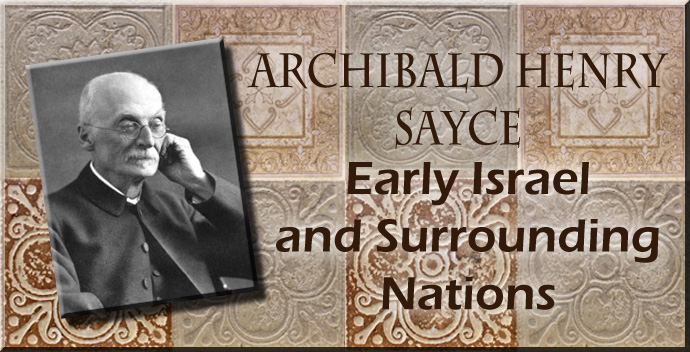
Early Israel and Surrounding Nations
By Sayce, A. H. (Archibald Henry)
Chapter 7
|
CONCLUSION Our task is finished. We have passed under review some of the facts which have been won by modern discovery from the monuments of the nations who helped to create the history of Israel. That history no longer stands alone like a solitary peak rising from the plain. Egypt, Babylonia, and Assyria have yielded up their dead; Canaan and even Arabia are now beginning to do likewise. The Oriental world of the past is slowly developing before our eyes; centuries which were deemed pre-historic but a few years ago have now become familiar to us, and we can study the very letters written by the contemporaries and predecessors of Abraham, and read the same books as those that were read by them. A new light has been poured upon the Old Testament; its story has been supplemented and explained; its statements tested and proved. The Israelites were but one out of many branches of the same family. Their history is entwined around that of their brethren, their characteristics were shared by others of the same race. The Canaan they occupied was itself inhabited by more than one people, and after the first few years of invasion, its influence became strong upon them. In race, indeed, the Jew was by no means pure; at the outset a mixture of Israelite and Edomite, he was further mingled with Moabite and Philistine elements. The first king of Judah as a separate kingdom had an Ammonite mother, and bore an Ammonite name, while the portraits which surmount the names of Shishak's conquests in southern Palestine show that the old Amorite population was still predominant there. It was religion and history that made the Jew, not purity of race. That Egypt must have exercised an influence upon Israel has long been known. The Israelites were born as a nation in the land of Goshen, and the Exodus from Egypt is the starting-point of their national history. But it is only since the decipherment of the Egyptian inscriptions that it has been possible to determine how far this influence extended, and to what extent it prevailed. And the result is to show that it was negative rather than positive; that the regulations of the Mosaic Code were directed to preventing the people from returning to Egypt and its idolatries by suppressing all reference to Egyptian beliefs and customs, and silently contradicting its ideas and practices. Even the doctrine of the future life, and the resurrection of the body, which plays so prominent a part in Egyptian religion, is carefully avoided, and the Ten Commandments have little in common with the ethical code of Egypt. But while the influence of Egypt has thus been shown to be negative rather than positive, the influence of Babylonia has proved to be overwhelming. Perhaps this is one of the greatest surprises of modern research, though it might have been expected had we remembered that Abraham was a native of Babylonia, and that Israelites and Semitic Babylonians belonged to the same race. We have seen that the early culture of western Asia was wholly Babylonian, and that Babylonian influence continued undiminished there down to the days of the Exodus. The very mode of writing and the language of literature were Babylonian; the whole method of thought had been modelled after a Babylonian pattern for unnumbered generations. Israel in Goshen was no more exempt from these influences than were the patriarchs in Canaan. Babylonian influence is deeply imprinted on the Mosaic laws. The institution of the Sabbath went back to the Sumerian days of Chaldĉa; the name itself was of Babylonian origin. The great festivals of Israel find their counterparts on the banks of the Euphrates. Even the year of Jubilee was a Babylonian institution, and Gudea, the priest-king of Lagas, tells us that when he kept it the slave became "for seven days the equal of his master." It was only the form and application of the old institutions that were changed in the Levitical legislation. They were adapted to the needs of Israel, and associated with the events of its history. But in themselves they were all of Babylonian descent. There is yet one more lesson to be learnt from the revelations of the monuments. They have made it clear that civilisation in the East is immensely old. As far back as we can go we find there all the elements of culture; man has already invented a system of writing, and has made some progress in art. It is true that by the side of all this civilisation there were still races living in the lowest barbarism of the Stone Age, just as there were Tasmanians who employed stone weapons of palaeolithic shape less than sixty years ago; but between the civilised man of the Babylonian plain and the barbarians around him there existed the same gulf that exists to-day between the European and the savage. The history of the ancient East contains no record of the development of culture out of savagery. It tells us, indeed, of degeneracy and decay, but it knows of no period when civilisation began. So far as archaeology can teach us, the builders of the Babylonian cities, the inventors of the cuneiform characters, had behind them no barbarous past.
|
|
 |
 |
|
|
|
-
Site Navigation
 Home
Home What's New
What's New Bible
Bible Photos
Photos Hiking
Hiking E-Books
E-Books Genealogy
Genealogy Profile
Free Plug-ins You May Need
Profile
Free Plug-ins You May Need
 Get Java
Get Java.png) Get Flash
Get Flash Get 7-Zip
Get 7-Zip Get Acrobat Reader
Get Acrobat Reader Get TheWORD
Get TheWORD